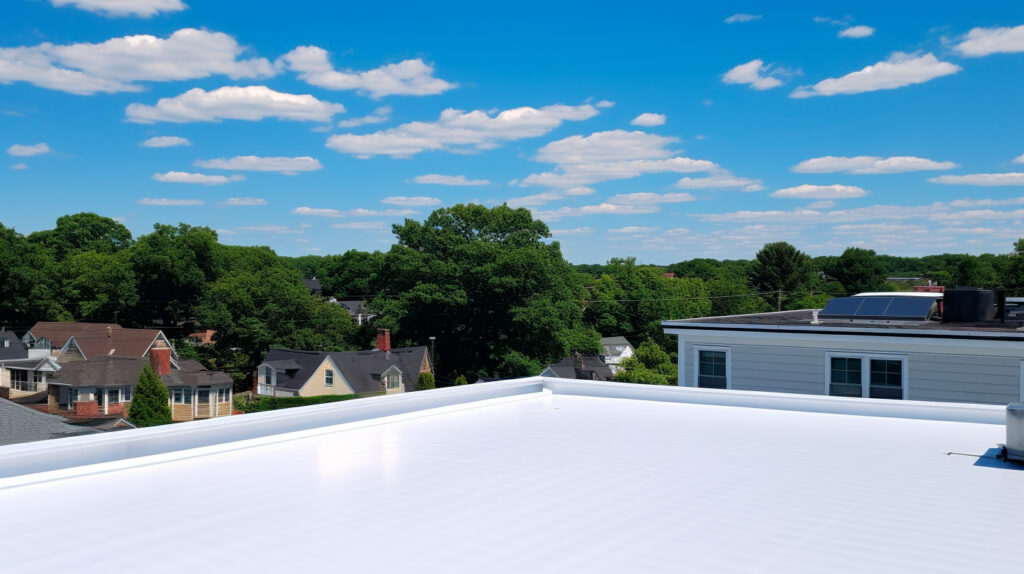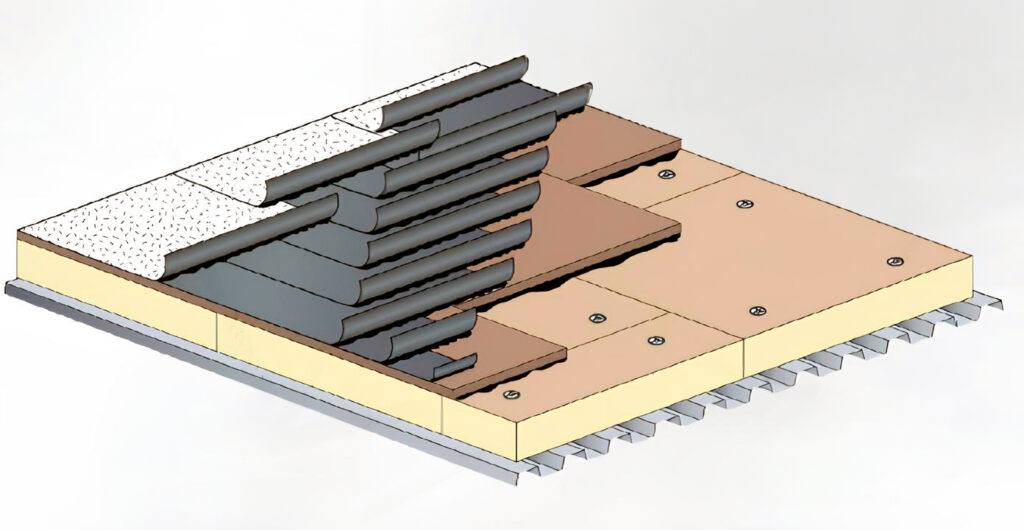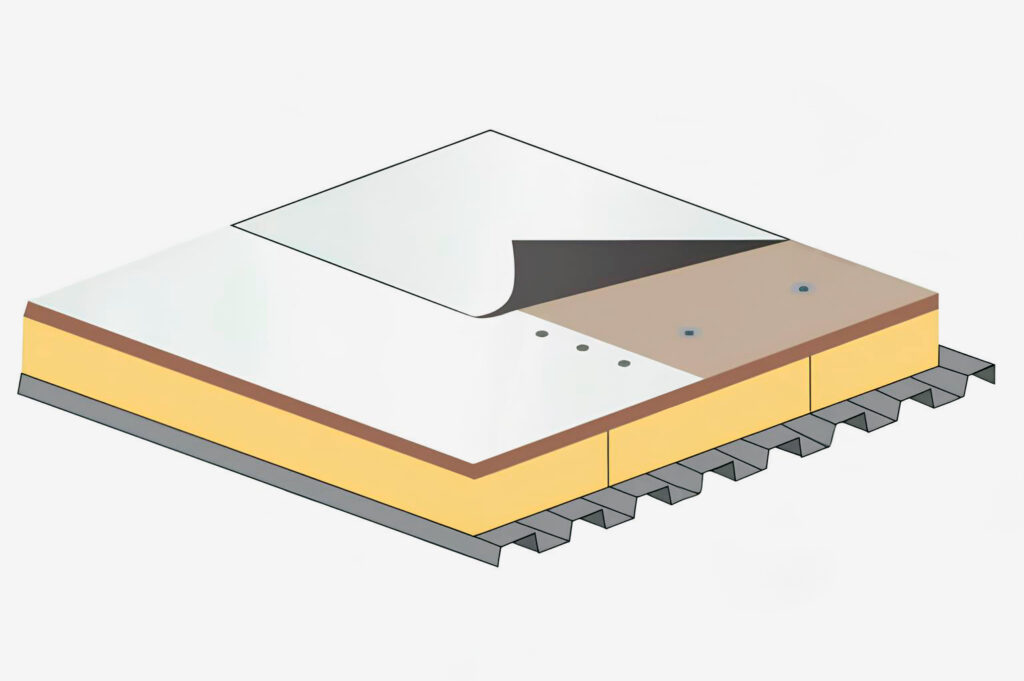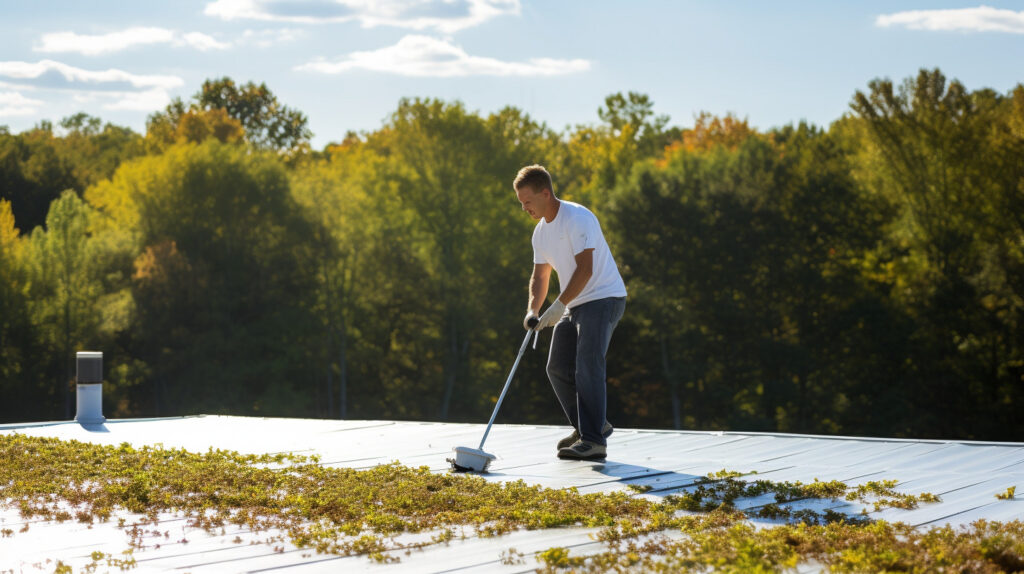Selecting a Membrane Roofing in Boston, Massachusetts
Reading Time: 5 minutesFlat and low-scope roofs are tricky to take care of because they store water, debris, snow, leaves, or other damaging objects and substances. Membrane roofing is a perfect solution for a rainy day.
Their intended purpose is to keep the moisture away. Plus, they protect you from UV rays and fire. However, it is a quest to determine which type of roof membrane pairs nicely with your project.
Long Story Short: What Is a Membrane Roofing?
Essentially, membrane roofing implies installing a continuous cover over a deck, insulation, and other inside parts of the roof. This surface generates a seal that shields the interior of a building from water or other deteriorating factors.

Unique Traits of a Membrane Roof System
- They are only suitable for flat and low-slope roofs.
- They create a necessary barrier between the negative outside impact (e.g., water, UV radiation, wind, lightning strikes, etc.) and space inside the premises.
- Their contemporary roofing materials make them extra resilient and immune to traditional roof destroyers, such as rust, mold, rot, moss, or insects.
- These roof systems will last for 20–30 years. Moreover, they require a minimum of maintenance. Still, they are not invincible, and the need for repair will occur within the first 5–15 years, depending on the quality of installation and maintenance.
Straightening the Record on Terminology:
The roofs are always partially prone, even when technically flat. After all, you still need a drainage system. Generally, membrane roofing applies to roofs that have a slope of 3/12 or less. A steep slope allows roofs to dispose of water naturally instead of accumulating it.
Possible Applications of Membrane Roofing Solutions
Due to its flat nature, these roofing systems are noticed predominantly on commercial buildings or premises, such as warehouses, logistics centers, supermarkets, or workshops.
Yet, their capabilities make them fit for public places (e.g., hospitals, schools, stadiums or sports centers, offices, etc.) and residential properties (e.g., hotels, apartments, patios, garages, etc.), especially single-ply roof membranes with enhanced energy efficiency. In addition, their capacity to provide a perfect platform for vegetation or solar panels boosts their value in aesthetic and practical aspects.
Defining Types of Roof Membranes
Naturally, membrane roofing hasn’t been on the market for as long as, for instance, timber. Yet, modern technologies provide means to create a wide selection of roof membranes. The main categorization criterion is the number of layers required to form a sealed surface.
Multi-ply membranes (two or three plies)

| Built-Up Roof Membranes (BUR) or Tar and Gravel Roofs | Modified Bitumen Membrane |
| Bitumen binder and reinforcing fabric merge to form a single roll. The bitumen membrane is polymer-modified: Styrene-butadiene-styrene (SBS) membranes are more flexible. Atactic polypropylene (APP) membranes imply a safer installation process. | Two-ply construction: Base sheet, Cap sheet, and surfacing.Three-ply construction: Base sheet, Reinforcing ply sheet; Cap sheet and surfacing. |
| Bitumen (asphalt or coal tar) is accommodated by reinforcing fabric sheets | Two-ply construction: Base sheet, Cap sheet, and surfacing.Three-ply construction: Base sheet, Reinforcing ply sheet; Cap sheet, and surfacing. |
Single-ply membranes

| PVC or Vinyl Roofing Membrane | EPDM Membrane | TPO Roofs |
| Polyvinyl Chloride (PVC) | Ethylene Propylene Diene Monomer (EPDM) | Thermoplastic Polyolefin (TPO) |
Clarity Note
These are the most popular types of single-ply membranes. However, there are more materials to explore, such as CSPE, PIB, CR, and ECH.
Terminology Confusion
Rubber roof is a term that unites multiple entities. Hence, it can describe SBS and APP in addition to EPDM roofing systems.
Installation Techniques for Membrane Roofing Systems
With a few exceptions, built-up or modified bitumen roofing system installation involves fire and harmful fumes, which inflict hazardous conditions upon construction workers, the environment, and neighbors.
Thus, homeowners switch their preferences to significantly more eco-friendly single-ply membranes. Yet, it is, indeed, the complexity of the installation process that enables multi-ply roofs to last longer (up to 40 years, to be precise).
Multi-ply Roofing Systems
| Built-Up Membranes | Modified Bitumen Membranes |
| Mechanically fastened base sheet | |
| Heated bitumen fused with sheets | Adhesive-backed, Hot-mopped, Torch-welded. |
Single-ply Roofing Systems
| Thermoset Membrane: | Thermoplastic Membrane: |
| You form a seamless surface with adhesives or fasteners. | You can apply heat to merge the sheets and seal the surface (heat welding). |
| Fully adhered; Mechanically fastened; Heat-welded. | Fully adhered; Mechanically fastened;Heat-welded. |
| EPDM | PVC and TPO |
Important Reminder
You should attach the membrane only after installing a deck and insulation, regardless of your selected type.
Maintaining Membrane Roofing for Longevity and Efficiency
Membrane roofing exists to keep you free from unnecessary hustle. Every type is a low-maintenance solution by design. Of course, your roof needs regular inspections and calls for occasional repairs. Yet, taking care of it won’t be overwhelming.

However, there are several aspects that you need to keep in mind before making a choice:
- Built-up and modified bitumen membranes demonstrate enhanced strength. However, multiple layers make it challenging to find a leak.
- After intense rains or snowstorms, check flat or low-slope roofs for standing water, ice, and snow.
- PVC and TPO roofs require many special tools to fix the occasional damage. Therefore, they call for a visit of qualified specialists more often.
- A fluid-applied liquid membrane makes the repairs more accessible. You can also use it as a protective coating or a cover for complicated shapes and forms.
Estimated Lifespan
Overall, membrane roofing is a long-lasting solution. However, it can slightly fluctuate, depending on the type of membrane.
| Built-Up | Modified Bitumen | Single-Ply |
| 20-40 | 20-30 | 15-20 (TPO);20-30 (PVC and EPDM). |
Vulnerabilities
You might be under the false impression that membrane roofs are invincible. Indeed, they are immune to the most common roof enemies like rot, moss, or rust. Still, particular factors can significantly undermine your roof’s well-being.
- Incorrect installation will soon cause irreparable troubles.
- Only EPDM can survive in the cold climate because it’s not afraid of freezing. Other materials will become fragile in extremely low temperatures.
Distinguishing Features
| Built-Up Membranes | Modified Bitumen Membranes | Single-Ply Membranes |
| Waterproof | ||
| Resistance to fire, UV radiation, high winds, or foot traffic (but only with a protective coating) | Resistance to fire, UV radiation, high winds, high temperatures, or puncture | |
| Has the longest life expectancy | Flexible and durable | Flexible and versatile; Eco-friendly; Energy-efficient (keeps the heat outside in hot weather, prevents heat losses during cold months). |
Membrane Roofing Prices in Boston, Massachusetts
Of course, built-up and modified bitumen are outdated compared to single-ply membranes developed with the most advanced contemporary technologies. Therefore, PVC, TPO, or EPDM will cost twice as much as a built-up or modified bitumen roofing system.
| Built-Up | Modified Bitumen | Single-Ply |
| $2.75 to $6 per square foot | $4.00 to $7.50 per square foot | $8.50 to $14.50 per square foot (PVC and TPO);$7.50 and $12.50 per square foot (EPDM). |
Word of Advice
Always search for up-to-date prices because they shift drastically with time, and you risk basing your decision on outdated information.
Conclusion
Membrane roofing, ideal for flat or low-slope roofs, is particularly effective in Boston, Massachusetts, where extensive rains and snowfalls are common. For the best results, you should consult roofing professionals who can guide you in choosing the right type. Built-up roofs, known for impressive longevity, modified bitumen membranes that offer flexibility and durability, and single-ply roofing systems, which provide ease of installation, eco-friendliness, added protection, and energy efficiency, are all excellent options that a specialist can help tailor to your needs.
Denis is the driving force behind ID Flat Roof, a leading company in Boston specializing in flat roof repair and installation for over 20 years.
Expertise:
Denis excels in PVC, TPO, EPDM, and rubber roofing. His meticulous approach ensures quality and customer satisfaction.
Innovation:
Denis incorporates cutting-edge solutions like skylights and solar PV roofing.



